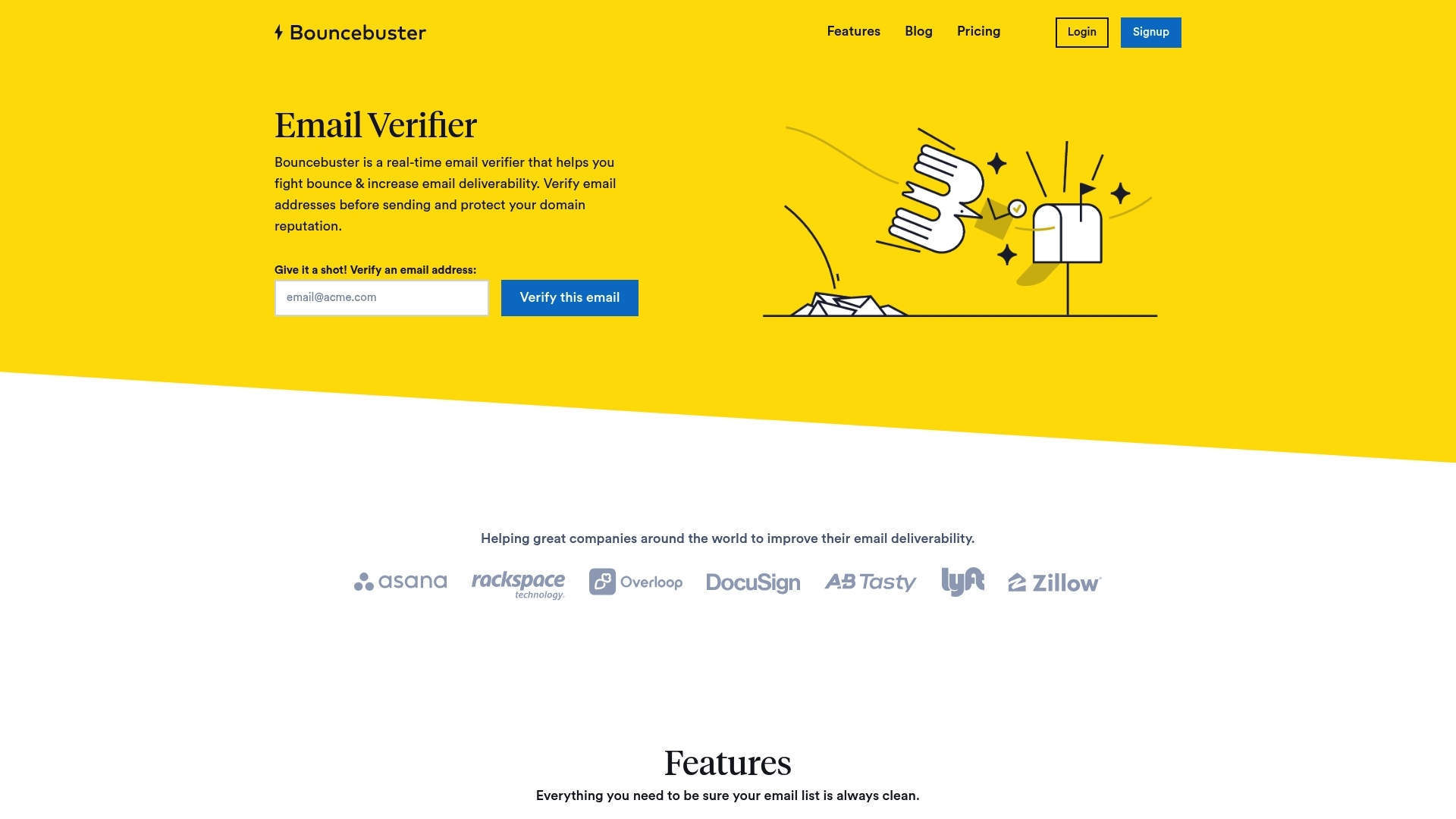10 Proven Ways to Verify Email and Boost Campaign Success
Unverified email addresses can quietly sabotage even the best marketing campaigns. Businesses and marketers face several challenges when sending to poor-quality lists, including increased bounce rates, deliverability issues, and missed connections with real people. These problems not only damage sender reputation but also drain resources and limit results. To address these risks, verifying email addresses before launching outreach is now an industry best practice.
Email verification tools simplify the process, helping you remove invalid or risky emails, improve deliverability, and reach genuine recipients. Solutions range from bulk list verifiers like BounceBuster to real-time API integrations and one-off address checks. Choosing the right method keeps your database healthy and your campaigns effective. To learn more about the advantages and details of email verification, you can always check out our blog.
Quick Comparison of Email Verification Methods
| Method | Key Features | Best For |
|---|---|---|
| BounceBuster Bulk Verification | Bulk uploads, real-time validation, dashboard, planned CRM integrations | Keeping large email lists clean |
| Hunter / ZeroBounce (Single-Email) | Instant email checks, browser-based | Quick verification before sending |
| NeverBounce / EmailListVerify (API-Driven) | Real-time API validation in forms/CRMs | Continuous automated verification |
| Marketing Platform Integrations | Direct plugin sync with Mailchimp, HubSpot, etc. | Automatic verification during list growth |
Below are ten proven ways to verify email addresses online and boost your campaign performance. Each method combines efficiency with reliability, giving you practical steps to maintain a strong and responsive email list.
1. Use BounceBuster for Reliable Bulk Email Verification
Managing a large email list can be challenging when you need to ensure every address is valid before sending a campaign. BounceBuster solves this by letting users upload entire lists—using CSV or XLS files—for automated bulk verification. The tool instantly reviews thousands of addresses, flagging invalid, inactive, or risky emails so you only keep what works. This process helps prevent bounces and protects sender reputation, making it a practical option for teams that handle high-volume campaigns. For full details on what BounceBuster can do, check out the features page.
Key Features for Efficient List Management
- Real-time Validation: BounceBuster checks each address quickly, identifying outdated or fake emails on the spot.
- User-Friendly Dashboard: Marketers can view results, download cleansed lists, and monitor list quality with an easy interface.
- Integration Capabilities: Developers can use the REST API to connect BounceBuster directly to CRMs or sign-up forms, automating verification with every new subscriber.
This approach removes the need for tedious manual checks and gives businesses current, actionable contacts. For anyone responsible for campaign performance, maintaining clean data with a bulk email verifier like BounceBuster reduces wasted effort and helps achieve higher deliverability.
2. Leverage Single-Email Verification Tools for Quick Checks
Sometimes you need to confirm a single email address—fast. Single-email verification tools like Hunter and ZeroBounce specialize in this, offering instant results directly from your browser. Marketers often rely on these quick checks before sending proposals, onboarding new subscribers, or evaluating leads in real time.
When Quick Verification Is Essential
- Validating a new sign-up before manual account approval
- Checking the authenticity of high-value leads or business contacts
- Confirming addresses in support tickets or customer chats
- Reducing bounce risk for targeted, personal email campaigns
These tools deliver results in seconds, flagging invalid domains, typo errors, blocked emails, and disposable addresses. With this information, marketers can act immediately—either adding the address to a nurtured list or rejecting it to avoid future campaign issues. For users who need both bulk and individual checks, Bouncebuster offers manual verification as part of its service, providing the flexibility for day-to-day contact validation. This approach ensures your campaigns start with accurate contacts, even for one-off sends. Learn more about cost-effective solutions on our pricing page.
3. Integrate API-Driven Email Verification Solutions
Manual email validation slows down workflows and often leads to errors. Verification APIs streamline this process by connecting directly to your sign-up forms, CRMs, or applications. Tools like NeverBounce and EmailListVerify offer real-time checks, confirming whether an address is accurate the moment someone enters it.
Why Use API Integrations for Email Verification
- Real-Time Protection: Instantly stop invalid emails from entering your database, preventing hard bounces before they happen.
- Automation: Verification works in the background, so team members don’t need to check addresses manually.
- Reduced Human Error: APIs lower the chance of typos or missed steps, leading to cleaner data from the start.
- Seamless Scaling: As your sign-up rate grows, API solutions handle any volume without slowing down operations.
Many platforms now support API connections natively or with minimal setup, allowing even non-technical teams to add verification quickly. Bouncebuster also provides an API, helping you automate verification directly in your lead-capture process for continuous list health. If you want to learn how to leverage Bouncebuster’s API, check out our documentation. API-driven methods let your systems talk to each other, making reliable email validation a routine part of your marketing operations.
4. Deploy Email Verification Plugins in Marketing Platforms
Email marketing platforms like Mailchimp and HubSpot allow you to extend their capabilities with plugins that verify email addresses as users join your list. These direct integrations work in the background, checking new addresses at the point of entry, which helps prevent invalid or risky contacts from polluting your main database.
Benefits of Integrated Verification
- Automatic Checks: Every new subscriber gets verified instantly, so only valid emails make it to your campaigns.
- Seamless Synchronization: Updates in your email or CRM platform stay aligned with your verified list, reducing the need for manual clean-up.
- Workflow Improvement: Marketers save time by eliminating repetitive manual verifications, allowing a focus on campaign strategy.
Tools like these close the gap between data collection and verification. Plugins designed for marketing platforms also fit naturally into existing workflows, supporting both automation and data accuracy with minimal setup. Services such as Bouncebuster plan to offer similar integrations, connecting email verification directly with tools businesses already use. This approach strengthens overall list quality and makes routine maintenance far simpler. For deeper understanding of improving sender reputation, check out our guide.
5. Run Syntax and Format Validation Checks
5. Run Syntax and Format Validation Checks
Even before reviewing whether an email address exists, filtering out obviously invalid addresses by syntax and format saves time and resources. Simple automatic checks—using standalone tools or scripts—block common errors that prevent emails from reaching inboxes. These checks identify entries that do not meet standard email conventions and remove them instantly from your list.
Core syntax and format validations include:
- Presence of a single ‘@’ character separating the username and domain
- Detection of incomplete domains (e.g., missing “.com”)
- Forbidding special characters such as commas, spaces, or angle brackets
- Length restrictions and catch of trailing/leading periods
Popular libraries for these checks include email-verifier (Python), and basic regex validators found in web forms and CRMs. Many email marketing platforms perform these validations automatically on import. For bulk uploads, cleaning tools like Bouncebuster run extensive format reviews before deeper validation steps, reducing manual list scrubbing and eliminating avoidable bounces.
This baseline layer of validation forms the first line of defense, letting only properly structured addresses through to more advanced checks. It increases list quality and ensures down-the-line verification resources focus on addresses with real delivery potential.
6. Identify Disposable and Temporary Email Addresses
Flagging Disposable and Temporary Email Addresses
Disposable and temporary email addresses create challenges for campaigns because they often come from users trying to bypass sign-up requirements or automated bots. These addresses typically expire quickly or route to non-permanent inboxes. Their presence can pollute your list, trigger spam filters, and lower engagement rates.
To maintain list quality, use detection tools that specifically identify and filter out these risky addresses. Services like Verifalia and EmailMarker compare incoming emails against databases of known disposable and temporary providers. When a match is found, these tools automatically flag or remove such entries before they reach your campaign queue.
Removing disposables has clear advantages:
- Prevents wasted sends to addresses that will never be checked
- Protects sender reputation from potential spam traps
- Keeps engagement metrics accurate by reducing artificial or short-lived contacts
Some bulk verifiers, including Bouncebuster, incorporate disposable email detection as part of their standard validation process, making it easy to screen your lists automatically with every upload. Effective filtering ensures you focus your outreach on real, engaged recipients who are more likely to interact with your message and contribute to campaign success.
7. Verify Domains with DNS Lookups
Verify Domains with DNS Lookups
After checking email syntax and format, the next step is to confirm that the domain of each address can actually receive messages. Domain Name System (DNS) lookups serve this purpose by querying public records to verify if a domain exists and has the correct mail server configurations (MX records). This process filters out addresses with expired, mistyped, or fake domains before you send emails.
DNS lookups help identify:
- Nonexistent domains caused by typos (e.g., “gmaill.com” instead of “gmail.com”)
- Domains missing essential MX records, which cannot accept incoming mail
- Suspicious or parked domains that often trap senders or cause bounces
MXToolbox and DNSChecker are popular tools that quickly check domain status and mail server settings. List cleaning platforms like Bouncebuster include DNS validation automatically as part of their verification process. Catching these issues early stops messages from being sent to dead ends, saving you delivery attempts and reducing hard bounces.
Regular domain checks are essential for anyone maintaining a list where domains may change status over time, helping keep deliverability high and sender score intact.
8. Authenticate Inbox Activity Through Mailbox Ping
Authenticate Inbox Activity Through Mailbox Ping
After removing disposable addresses, another layer of email verification helps ensure you send messages only to active and reachable inboxes. Mailbox pinging checks whether an inbox is live by simulating a connection to the mail server. Tools like Proofy use this method to verify if the mailbox can accept messages without delivering a test email, helping reduce bounce rates further.
Mailbox pinging is valuable in these situations:
- Cleaning older lists that may have outdated or abandoned emails
- Confirming engagement for high-value recipients before personalized sends
- Filtering out addresses that technically exist but no longer actively receive mail
This technique checks if the email server responds positively during the handshake process, indicating the mailbox is maintained and accepting new messages. Some verification services integrate mailbox pinging as a core feature to refine deliverability predictions. Bouncebuster includes mailbox activity checks within its validation steps, ensuring marketers and businesses avoid reaching out to dormant or invalid emails. If you’re curious about the documentation on this process, refer to the documentation. This extra verification layer protects sender reputation by minimizing unnecessary bounces and keeping lists highly responsive.
9. Cross-Reference Against Blacklists and Spam Traps
Sending emails to addresses found on blacklists or associated with spam traps can harm sender reputation and campaign results. To avoid these risks, cross-reference your email list with trusted blacklist and anti-spam databases. Services like CleanTalk and Spamhaus allow users to check if specific addresses, domains, or IPs appear on known blacklists. By screening your contacts against these services, you proactively filter out potentially harmful addresses before each campaign.
- Blacklist Checks: Identify emails, domains, or IPs reported for spam or fraudulent activities. Remove listings immediately to avoid deliverability issues.
- Spam Trap Detection: Prevent sending to addresses specifically set up to catch senders using outdated or purchased lists.
Many reputable email verification platforms, Bouncebuster included, factor blacklist and spam trap cross-referencing into their process. This additional layer protects campaigns from being flagged by receiving servers, reduces bounce rates, and safeguards overall sender reputation. Regular use of blacklist checks supports a positive delivery track record, ensuring messages reach real, engaged recipients instead of getting blocked or filtered out.
10. Schedule Regular Automated List Cleaning
Automate List Cleaning With Trusted Tools
Maintaining list quality isn’t a one-time task. Email lists age quickly as contacts change jobs, abandon accounts, or enter emails with typos. To keep your campaigns performing, schedule regular, automated cleaning using reliable tools. Automated services such as ListWise and Snov.io let you set cleaning intervals so your database stays updated without manual effort. These solutions scan your lists for invalid, risky, or outdated contacts, then remove or flag them automatically.
- Set-and-forget scheduling: Pick daily, weekly, or monthly cycles to match your campaign pace.
- Continuous validation: Lists are rechecked routinely, catching issues before you send bulk campaigns.
- Optimized ROI: Clean lists help reduce bounces and improve engagement, making sure your budget targets real users, not abandoned inboxes.
By automating this process, companies minimize time spent on data hygiene and avoid manual mistakes. Platforms like Bouncebuster also offer automated bulk verification, so teams can keep lists clean by default as they scale. For more expert tips about maintaining list quality and deliverability, visit our blog. Consistent, scheduled cleaning delivers stronger performance, protects sender reputation, and ensures that your marketing investment directly supports long-term results.
Conclusion: Next Steps to Ensure Campaign Deliverability
Mastering email verification is one of the fastest ways to reduce bounce rates, protect sender reputation, and consistently reach engaged recipients. Each method shared—from bulk list cleaning with tools like BounceBuster to automated API checks, syntax reviews, and blacklist screening—addresses a specific vulnerability in your email workflow. Relying on trusted solutions at every stage keeps your campaigns out of spam folders and maximizes open and click rates.
Key Steps for Maintaining Email List Health
- Use bulk verifiers and single-address tools to keep both small and large lists accurate.
- Integrate verification APIs or platform plugins to automate address checks as contacts enter your CRM or marketing database.
- Apply syntax and format validation to filter out common email entry errors before deeper scanning.
- Detect and remove disposable, temporary, or blacklisted emails to improve list quality and message delivery.
- Set up routine, scheduled cleaning so your list stays up to date even as user data changes over time.
Maintaining a verified email database is not a one-time task, but a continuous process. Automating and layering these checks leaves little room for error and ensures each campaign reaches as many real recipients as possible. Solutions like BounceBuster support this with features that adapt to busy marketing teams and evolving data needs. By adopting these strategies, you can expect fewer bounce-backs, stronger engagement, and improved ROI on every campaign sent.
For anyone who wants reliable deliverability, regularly applying these best practices ensures that every message counts. Start refining your approach today by combining the tools and steps that best fit your organization’s needs, and keep your database—and your results—growing over the long term.




